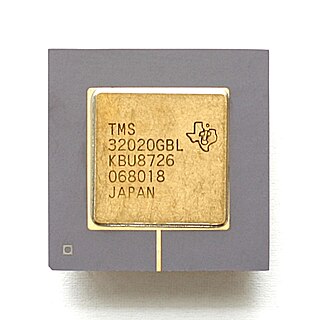MIPS is a family of reduced instruction set computer (RISC) instruction set architectures (ISA) developed by MIPS Computer Systems, now MIPS Technologies, based in the United States.

In electronics and computer science, a reduced instruction set computer (RISC) is a computer architecture designed to simplify the individual instructions given to the computer to accomplish tasks. Compared to the instructions given to a complex instruction set computer (CISC), a RISC computer might require more instructions in order to accomplish a task because the individual instructions are written in simpler code. The goal is to offset the need to process more instructions by increasing the speed of each instruction, in particular by implementing an instruction pipeline, which may be simpler to achieve given simpler instructions.
In computer science, an instruction set architecture (ISA) is an abstract model that generally defines how software controls the CPU in a computer or a family of computers. A device or program that executes instructions described by that ISA, such as a central processing unit (CPU), is called an implementation of that ISA.
Very long instruction word (VLIW) refers to instruction set architectures that are designed to exploit instruction-level parallelism (ILP). A VLIW processor allows programs to explicitly specify instructions to execute in parallel, whereas conventional central processing units (CPUs) mostly allow programs to specify instructions to execute in sequence only. VLIW is intended to allow higher performance without the complexity inherent in some other designs.

Single instruction, multiple data (SIMD) is a type of parallel processing in Flynn's taxonomy. SIMD can be internal and it can be directly accessible through an instruction set architecture (ISA), but it should not be confused with an ISA. SIMD describes computers with multiple processing elements that perform the same operation on multiple data points simultaneously.

AVR is a family of microcontrollers developed since 1996 by Atmel, acquired by Microchip Technology in 2016. These are modified Harvard architecture 8-bit RISC single-chip microcontrollers. AVR was one of the first microcontroller families to use on-chip flash memory for program storage, as opposed to one-time programmable ROM, EPROM, or EEPROM used by other microcontrollers at the time.
The Intel i860 is a RISC microprocessor design introduced by Intel in 1989. It is one of Intel's first attempts at an entirely new, high-end instruction set architecture since the failed Intel iAPX 432 from the beginning of the 1980s. It was the world's first million-transistor chip. It was released with considerable fanfare, slightly obscuring the earlier Intel i960, which was successful in some niches of embedded systems. The i860 never achieved commercial success and the project was terminated in the mid-1990s.

A digital signal processor (DSP) is a specialized microprocessor chip, with its architecture optimized for the operational needs of digital signal processing. DSPs are fabricated on metal–oxide–semiconductor (MOS) integrated circuit chips. They are widely used in audio signal processing, telecommunications, digital image processing, radar, sonar and speech recognition systems, and in common consumer electronic devices such as mobile phones, disk drives and high-definition television (HDTV) products.
Transmeta Corporation was an American fabless semiconductor company based in Santa Clara, California. It developed low power x86 compatible microprocessors based on a VLIW core and a software layer called Code Morphing Software.

A coprocessor is a computer processor used to supplement the functions of the primary processor. Operations performed by the coprocessor may be floating-point arithmetic, graphics, signal processing, string processing, cryptography or I/O interfacing with peripheral devices. By offloading processor-intensive tasks from the main processor, coprocessors can accelerate system performance. Coprocessors allow a line of computers to be customized, so that customers who do not need the extra performance do not need to pay for it.
Nucleus RTOS is a real-time operating system (RTOS) produced by the Embedded Software Division of Mentor Graphics, a Siemens Business, supporting 32- and 64-bit embedded system platforms. The operating system (OS) is designed for real-time embedded systems for medical, industrial, consumer, aerospace, and Internet of things (IoT) uses. Nucleus was released first in 1993. The latest version is 3.x, and includes features such as power management, process model, 64-bit support, safety certification, and support for heterogeneous computing multi-core system on a chip (SOCs) processors.

Blackfin is a family of 16-/32-bit microprocessors developed, manufactured and marketed by Analog Devices. The processors have built-in, fixed-point digital signal processor (DSP) functionality performed by 16-bit multiply–accumulates (MACs), accompanied on-chip by a microcontroller. It was designed for a unified low-power processor architecture that can run operating systems while simultaneously handling complex numeric tasks such as real-time H.264 video encoding.

In computing, a benchmark is the act of running a computer program, a set of programs, or other operations, in order to assess the relative performance of an object, normally by running a number of standard tests and trials against it.

TMS320 is a blanket name for a series of digital signal processors (DSPs) from Texas Instruments. It was introduced on April 8, 1983, through the TMS32010 processor, which was then the fastest DSP on the market.
In computer science, stream processing is a programming paradigm which views streams, or sequences of events in time, as the central input and output objects of computation. Stream processing encompasses dataflow programming, reactive programming, and distributed data processing. Stream processing systems aim to expose parallel processing for data streams and rely on streaming algorithms for efficient implementation. The software stack for these systems includes components such as programming models and query languages, for expressing computation; stream management systems, for distribution and scheduling; and hardware components for acceleration including floating-point units, graphics processing units, and field-programmable gate arrays.

A multi-core processor (MCP) is a microprocessor on a single integrated circuit (IC) with two or more separate central processing units (CPUs), called cores to emphasize their multiplicity. Each core reads and executes program instructions, specifically ordinary CPU instructions. However, the MCP can run instructions on separate cores at the same time, increasing overall speed for programs that support multithreading or other parallel computing techniques. Manufacturers typically integrate the cores onto a single IC die, known as a chip multiprocessor (CMP), or onto multiple dies in a single chip package. As of 2024, the microprocessors used in almost all new personal computers are multi-core.

The Parallax P8X32A Propeller is a multi-core processor parallel computer architecture microcontroller chip with eight 32-bit reduced instruction set computer (RISC) central processing unit (CPU) cores. Introduced in 2006, it is designed and sold by Parallax, Inc.

TILE64 is a VLIW ISA multicore processor manufactured by Tilera. It consists of a mesh network of 64 "tiles", where each tile houses a general purpose processor, cache, and a non-blocking router, which the tile uses to communicate with the other tiles on the processor.

TriMedia is a family of very long instruction word media processors from NXP Semiconductors. TriMedia is a Harvard architecture CPU that features many DSP and SIMD operations to efficiently process audio and video data streams. For TriMedia processor optimal performance can be achieved by only programming in C/C++ as opposed to most other VLIW/DSP processors which require assembly language programming to achieve optimal performance. High-level programmability of TriMedia relies on the large uniform register file and the orthogonal instruction set, in which RISC-like operations can be scheduled independently of each other in the VLIW issue slots. Furthermore, TriMedia processors boast advanced caches supporting unaligned accesses without performance penalty, hardware and software data/instruction prefetch, allocate-on-write-miss, as well as collapsed load operations combining a traditional load with a 2-taps filter function. TriMedia development has been supported by various research studies on hardware cache coherency, multithreading and diverse accelerators to build scalable shared memory multiprocessor systems.
In computing, a cache control instruction is a hint embedded in the instruction stream of a processor intended to improve the performance of hardware caches, using foreknowledge of the memory access pattern supplied by the programmer or compiler. They may reduce cache pollution, reduce bandwidth requirement, bypass latencies, by providing better control over the working set. Most cache control instructions do not affect the semantics of a program, although some can.












